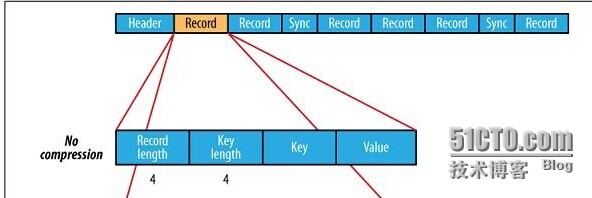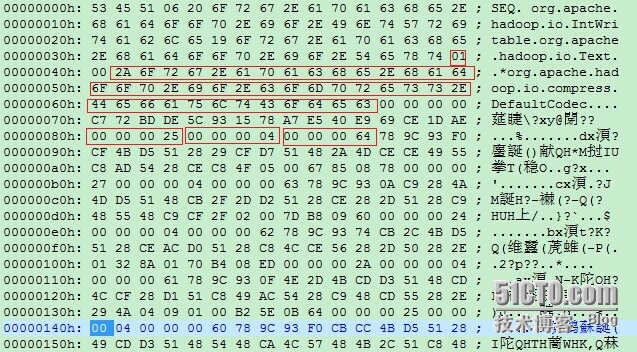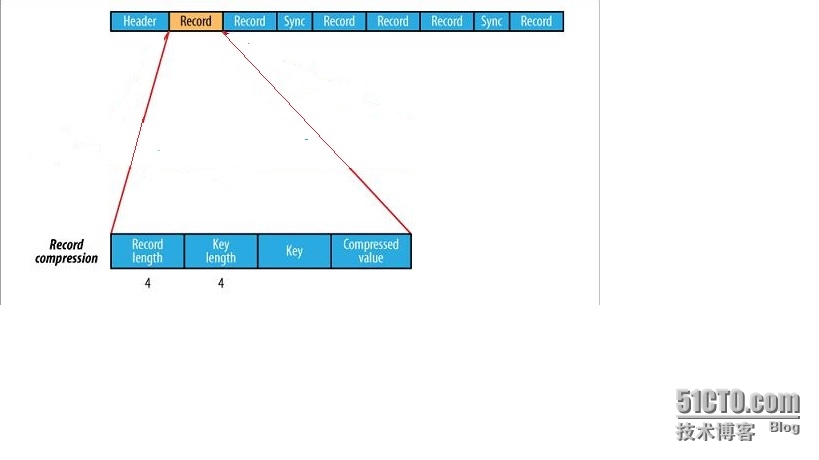hadoop SequenceFile介紹 大資料 儲存
SequenceFile是一個由二進位制序列化過的key/value的位元組流組成的文字儲存檔案。
基於壓縮型別CompressType,共有三種SequenceFileWriter:
| 1 2 3 4 5 6 7 8 |
public static enum CompressionType {
/** 不壓縮 */
NONE,
/** 只壓縮value */
RECORD,
/** 壓縮很多記錄的key/value成一塊 */
BLOCK
}
|
There are three
SequenceFileWriters based on the CompressType
used to compress key/value pairs:
1、Writer : Uncompressed records.
在SequenceFile裡有Writer的實現,原始碼如下:
| 1 |
public static class Writer implements java.io.Closeable, Syncable
|
| 1 2 3 4 5 6 7 8 9 10 11 12 13 14 15 16 17 |
/** Write and flush the file header. */
private void writeFileHeader()
throws IOException {
out.write(VERSION);
Text.writeString(out, keyClass.getName());
Text.writeString(out, valClass.getName());
out.writeBoolean(this.isCompressed());
out.writeBoolean(this.isBlockCompressed());
if (this.isCompressed()) {
Text.writeString(out, (codec.getClass()).getName());
}
this.metadata.write(out);
out.write(sync); // write the sync bytes
out.flush(); // flush header
}
|
首先SequenceFile檔案有個表頭,以上是寫表頭的程式碼,我們以一個例項結合程式碼來看一下表頭的組成。
| 1 2 3 4 5 6 7 8 9 10 11 12 13 14 15 16 17 18 19 20 21 22 23 24 25 26 27 28 29 30 31 32 33 34 35 36 37 38 39 40 41 42 43 44 45 46 47 48 49 50 51 52 53 54 55 56 57 58 |
package demo;
import java.io.IOException;
import java.net.URI;
import org.apache.hadoop.conf.Configuration;
import org.apache.hadoop.fs.FileSystem;
import org.apache.hadoop.fs.Path;
import org.apache.hadoop.io.IOUtils;
import org.apache.hadoop.io.IntWritable;
import org.apache.hadoop.io.SequenceFile;
import org.apache.hadoop.io.SequenceFile.CompressionType;
import org.apache.hadoop.io.Text;
public class SequenceFileWriteDemo {
private static final String[] DATA = { "One, two, buckle my shoe",
"Three, four, shut the door", "Five, six, pick up sticks",
"Seven, eight, lay them straight", "Nine, ten, a big fat hen" };
public static void main(String[] args) throws IOException {
String uri = args[0];
Configuration conf = new Configuration();
conf.set("fs.defaultFS", "hdfs://xxx.xxx.xxx.xx:9000");
FileSystem fs = FileSystem.get(URI.create(uri), conf);
Path path = new Path(uri);
IntWritable key = new IntWritable();
Text value = new Text();
SequenceFile.Writer writer = null;
try {
String compressType = args[1];
System.out.println("compressType "+compressType);
// Writer : Uncompressed records.
if(compressType.equals("1") ){
System.out.println("compress none");
writer = SequenceFile.createWriter(fs, conf, path, key.getClass(),value.getClass(),CompressionType.NONE);
}else if(compressType .equals("2") ){
System.out.println("compress record");
//RecordCompressWriter : Record-compressed files, only compress values.
writer = SequenceFile.createWriter(fs, conf, path, key.getClass(),value.getClass(),CompressionType.RECORD);
}else if(compressType.equals("3") ){
System.out.println("compress block");
// BlockCompressWriter : Block-compressed files, both keys & values are collected in 'blocks' separately and compressed. The size of the 'block' is configurable.
writer = SequenceFile.createWriter(fs, conf, path, key.getClass(),value.getClass(),CompressionType.BLOCK);
}
for (int i = 0; i < 100; i++) {
key.set(100 - i);
value.set(DATA[i % DATA.length]);
System.out.printf("[%s]\t%s\t%s\n", writer.getLength(), key,value);
writer.append(key, value);
}
} finally {
IOUtils.closeStream(writer);
}
}
}
|
存入的文字檔案內容如下:
key value
100 One, two, buckle my shoe
99 Three, four, shut the door
98 Five, six, pick up sticks
97 Seven, eight, lay them straight
96 Nine, ten, a big fat hen
95 One, two, buckle my shoe
94 Three, four, shut the door
93 Five, six, pick up sticks
92 Seven, eight, lay them straight
91 Nine, ten, a big fat hen
90 One, two, buckle my shoe
89 Three, four, shut the door
88 Five, six, pick up sticks
87 Seven, eight, lay them straight
86 Nine, ten, a big fat hen
85 One, two, buckle my shoe
84 Three, four, shut the door
83 Five, six, pick up sticks
82 Seven, eight, lay them straight
81 Nine, ten, a big fat hen
80 One, two, buckle my shoe
79 Three, four, shut the door
78 Five, six, pick up sticks
77 Seven, eight, lay them straight
76 Nine, ten, a big fat hen
75 One, two, buckle my shoe
74 Three, four, shut the door
73 Five, six, pick up sticks
72 Seven, eight, lay them straight
71 Nine, ten, a big fat hen
70 One, two, buckle my shoe
69 Three, four, shut the door
68 Five, six, pick up sticks
67 Seven, eight, lay them straight
66 Nine, ten, a big fat hen
65 One, two, buckle my shoe
64 Three, four, shut the door
63 Five, six, pick up sticks
62 Seven, eight, lay them straight
61 Nine, ten, a big fat hen
60 One, two, buckle my shoe
59 Three, four, shut the door
58 Five, six, pick up sticks
57 Seven, eight, lay them straight
56 Nine, ten, a big fat hen
55 One, two, buckle my shoe
54 Three, four, shut the door
53 Five, six, pick up sticks
52 Seven, eight, lay them straight
51 Nine, ten, a big fat hen
50 One, two, buckle my shoe
49 Three, four, shut the door
48 Five, six, pick up sticks
47 Seven, eight, lay them straight
46 Nine, ten, a big fat hen
45 One, two, buckle my shoe
44 Three, four, shut the door
43 Five, six, pick up sticks
42 Seven, eight, lay them straight
41 Nine, ten, a big fat hen
40 One, two, buckle my shoe
39 Three, four, shut the door
38 Five, six, pick up sticks
37 Seven, eight, lay them straight
36 Nine, ten, a big fat hen
35 One, two, buckle my shoe
34 Three, four, shut the door
33 Five, six, pick up sticks
32 Seven, eight, lay them straight
31 Nine, ten, a big fat hen
30 One, two, buckle my shoe
29 Three, four, shut the door
28 Five, six, pick up sticks
27 Seven, eight, lay them straight
26 Nine, ten, a big fat hen
25 One, two, buckle my shoe
24 Three, four, shut the door
23 Five, six, pick up sticks
22 Seven, eight, lay them straight
21 Nine, ten, a big fat hen
20 One, two, buckle my shoe
19 Three, four, shut the door
18 Five, six, pick up sticks
17 Seven, eight, lay them straight
16 Nine, ten, a big fat hen
15 One, two, buckle my shoe
14 Three, four, shut the door
13 Five, six, pick up sticks
12 Seven, eight, lay them straight
11 Nine, ten, a big fat hen
10 One, two, buckle my shoe
9 Three, four, shut the door
8 Five, six, pick up sticks
7 Seven, eight, lay them straight
6 Nine, ten, a big fat hen
5 One, two, buckle my shoe
4 Three, four, shut the door
3 Five, six, pick up sticks
2 Seven, eight, lay them straight
1 Nine, ten, a big fat hen
把以上java 打成jar,執行hadoop jar sfile.jar /test/numbers.seq 1 1代表不壓縮
hadoop fs -get hdfs:///test/numbers1.seq /usr/test/ 取出剛剛生成的檔案,我們用UE開啟看一下
0x53 0x45 0x51
這是SequenceFile Format的magic header「SEQ」,用來區別文字是否是「SequenceFile Format」。
0x06
版本編號,目前最新版為「SEQ6」
以上程式碼原始碼如下:
| 1 2 3 4 |
private static byte[] VERSION = new byte[] {
(byte)'S', (byte)'E', (byte)'Q', VERSION_WITH_METADATA
};
out.write(VERSION);
|
0x20 0x65........0x65
這部份是keyClassName(Key的類名),而第1個Byte(0x20)用來表示此字串的長度,此範例為org.apache.hadoop.io.IntWritable
以上程式碼原始碼如下:
| 1 |
Text.writeString(out, keyClass.getName());
|
0x19
0x6F ..... 0x74
這部份是valueClassName(Value的類名),第1個Byte(0x19)也是用來表示此字串的長度,此範例為org.apache.hadoop.io.BytesWritable
| 1 |
Text.writeString(out, valClass.getName());
|
0x00
是否compression?「0x00」=否 (此為Boolean所以佔1個Byte)
0x00
是否blockCompression?「0x00」=否(此為Boolean所以佔1個Byte)
| 1 2 |
out.writeBoolean(this.isCompressed());
out.writeBoolean(this.isBlockCompressed());
|
如果是壓縮的話接下去還會寫壓縮類,此範例沒有壓縮所以沒有此類名的寫入,原始碼如下:
| 1 2 3 |
if (this.isCompressed()) {
Text.writeString(out, (codec.getClass()).getName());
}
|
0x00
0x00 0x00 0x00
metadata,此範例沒有包含任何metadata,
所以輸出「0x00 0x00 0x00 0x00」
| 1 |
this.metadata.write(out);
|
0x76
0x61 ..... 0xAF
sync標記,用來表示一個「Header」的結束。
| 1 2 3 4 5 6 7 8 9 10 11 12 13 |
byte[] sync; // 16 random bytes
{
try {
MessageDigest digester = MessageDigest.getInstance("MD5");
long time = Time.now();
digester.update((new UID()+"@"+time).getBytes());
sync = digester.digest();
} catch (Exception e) {
throw new RuntimeException(e);
}
}
out.write(sync);
|
至此頭部檔案寫入完畢,可見頭部的格式可以歸納如下:
SequenceFile Header
-
version - 3 bytes of magic header SEQ, followed by 1 byte of actual version number (e.g. SEQ4 or SEQ6)
-
keyClassName -key class
-
valueClassName - value class
-
compression - A boolean which specifies if compression is turned on for keys/values in this file.
-
blockCompression - A boolean which specifies if block-compression is turned on for keys/values in this file.
-
compression codec -
CompressionCodecclass which is used for compression of keys and/or values (if compression is enabled). -
metadata - for this file.
-
sync - A sync marker to denote end of the header.
接下去我們看一下資料儲存格式:
0x00 0x00 0x00 0x1D
整個Record的size ,一個Record包含「Key、Value」。此處為29個位元組,因為 key=100 佔4個位元組,value=One, two, buckle my shoe 佔24位元組 還有一個位元組存了value的長度 所以 29位元組總共。
0x00 0x00 0x00 0x04
Key內容的size~ (此為Int所以佔4個位元組)
0x00 0x00 0x00 0x64
Key的內容,此處為100,那十六進位制就是64
0x18
value內容的size,此處是One, two, buckle my shoe,長度24 所以十六進位制就是18
0x4F 0X6E....0x65
value的內容One, two, buckle my shoe
以上程式碼原始碼如下:
| 1 2 3 4 5 6 7 8 |
public synchronized void append(Object key, Object val){
.......
// Write the record out
checkAndWriteSync(); // sync
out.writeInt(buffer.getLength()); // total record length
out.writeInt(keyLength); // key portion length
out.write(buffer.getData(), 0, buffer.getLength()); // data
}
|
當資料達到一個閥值,會寫sync,寫sync就是呼叫checkAndWriteSync(); 原始碼如下:
| 1 2 3 4 5 6 |
synchronized void checkAndWriteSync() throws IOException {
if (sync != null &&
out.getPos() >= lastSyncPos+SYNC_INTERVAL) { // time to emit sync
sync();
}
}
|
SYNC_INTERVAL定義如下:
| 1 2 3 4 5 |
private static final int SYNC_HASH_SIZE = 16; // number of bytes in hash
private static final int SYNC_SIZE = 4+SYNC_HASH_SIZE; // escape + hash
/** The number of bytes between sync points.*/
public static final int SYNC_INTERVAL = 100*SYNC_SIZE;
|
可見每2000byte會寫一個sync
SequeceFile 無壓縮圖示如下:
可見格式如下:
Uncompressed SequenceFile Format
-
Record
-
Record length
-
Key length
-
Key
-
Value
-
接下去我們看一下RecordCompressWriter
2、RecordCompressWriter : Record-compressed files, only compress values.
執行hadoop jar sfile.jar /test/numbers2.seq 2 2代表使用RecordCompressWriter壓縮
同樣我們用UE看一下生成的檔案:
可見表頭和不壓縮的基本一致,有些小區別如下:
0x01
代表使用了壓縮
0x2A 0x6F ....0x63
使用的壓縮類org.apache.hadoop.io.compress.DefaultCodec
0x00 ...0x25
整個Record的size ,為37,為啥比不壓縮佔用的位元組更多?
0x00 0x00 0x00 0x04
Key內容的size~ (此為Int所以佔4個位元組)
0x00 0x00 0x00 0x64
Key的內容,此處為100,那十六進位制就是64 可見key沒有壓縮
以上原始碼如下:
| 1 2 3 4 5 6 7 8 9 10 11 12 13 14 15 16 17 18 19 20 21 22 23 24 25 26 27 28 29 30 31 |
@Override
@SuppressWarnings("unchecked")
public synchronized void append(Object key, Object val)
throws IOException {
if (key.getClass() != keyClass)
throw new IOException("wrong key class: "+key.getClass().getName()
+" is not "+keyClass);
if (val.getClass() != valClass)
throw new IOException("wrong value class: "+val.getClass().getName()
+" is not "+valClass);
buffer.reset();
// Append the 'key'
keySerializer.serialize(key);
int keyLength = buffer.getLength();
if (keyLength < 0)
throw new IOException("negative length keys not allowed: " + key);
// Compress 'value' and append it
deflateFilter.resetState();
compressedValSerializer.serialize(val);
deflateOut.flush();
deflateFilter.finish();
// Write the record out
checkAndWriteSync(); // sync
out.writeInt(buffer.getLength()); // total record length
out.writeInt(keyLength); // key portion length
out.write(buffer.getData(), 0, buffer.getLength()); // data
}
|
SequeceFile 壓縮value圖示如下:
可見格式如下:
Record-Compressed SequenceFile Format
-
Record
-
Record length
-
Key length
-
Key
-
Compressed Value
-
接下去我們看一下BlockCompressWriter
3、BlockCompressWriter : Block-compressed files, both keys & values are collected in 'blocks' separately and compressed. The size of the 'block' is configurable.
執行hadoop jar sfile.jar /test/numbers3.seq 3 3代表使用BlockCompressWriter壓縮
同樣我們用UE看一下生成的檔案:
可見表頭和不壓縮的基本一致,有些小區別如下:
0x01
代表使用了壓縮
0x01
代表使用了block壓縮
對於block壓縮的原始碼如下:
| 1 2 3 4 5 6 7 8 9 10 11 12 13 14 15 16 17 18 19 20 21 22 23 24 25 26 27 28 29 |
public synchronized void append(Object key, Object val)
throws IOException {
if (key.getClass() != keyClass)
throw new IOException("wrong key class: "+key+" is not "+keyClass);
if (val.getClass() != valClass)
throw new IOException("wrong value class: "+val+" is not "+valClass);
// Save key/value into respective buffers
int oldKeyLength = keyBuffer.getLength();
keySerializer.serialize(key);
int keyLength = keyBuffer.getLength() - oldKeyLength;
if (keyLength < 0)
throw new IOException("negative length keys not allowed: " + key);
WritableUtils.writeVInt(keyLenBuffer, keyLength);
相關推薦hadoop SequenceFile介紹 大資料 儲存SequenceFile是一個由二進位制序列化過的key/value的位元組流組成的文字儲存檔案。 基於壓縮型別CompressType,共有三種SequenceFileWriter: 1 2 3 4 5 6 7 8 public static enum Co 【Hadoop & Hbase】大資料儲存系統程式設計_讀出寫入0x01 編譯環境 jdk 1.7 hbase 0.98 hadoop 2.6 Ubuntu Linux 14.04.2 0x02 目標 其中我的任務編號為5,即Sort-based Distinct Sort-based Distinct hadoop SequenceFile——大資料 儲存SequenceFile是一個由二進位制序列化過的key/value的位元組流組成的文字儲存檔案。 基於壓縮型別CompressType,共有三種SequenceFile Writer: public static enum CompressionType { / 《Hadoop 權威指南 - 大資料的儲存與分析》學習筆記第一章 初識Hadoop 1.2 資料的儲存與分析 對多個硬碟中的資料並行進行讀/寫資料,有以下兩個重要問題: 硬體故障問題。解決方案:複製(replication),系統儲存資料的副本(replica)。 以某種方式結合大部分資料來共同完成分析。MapReduce Hadoop權威指南-大資料的儲存與分析第四版——學習筆記——第2章——1MapReduce 適合處理半結構化的資料 MapReduce任務階段 Map階段+Reduce階段 Key-Value作為輸入輸出 實現兩個函式:map(),reduce() Map階段 輸入的Key:文字中的偏移量 輸入的value:文字 輸出的k-v給reduce處 《Hadoop權威指南大資料的儲存與分析第版修訂版升級版》pdf附網盤下載連結+(附一個菜鳥的java學習之路)技術書閱讀方法論 一.速讀一遍(最好在1~2天內完成) 人的大腦記憶力有限,在一天內快速看完一本書會在大腦裡留下深刻印象,對於之後複習以及總結都會有特別好的作用。 對於每一章的知識,先閱讀標題,弄懂大概講的是什麼主題,再去快速看一遍,不懂也沒有關係,但是一定要在不懂的 大資料儲存---HBase介紹(上)本次主要介紹三部分: HBase簡介 HBase整體架構 HBase安裝和啟動 Hbase基本操作 HBase簡介 hbase是bigtable的開源java版本,是建立在hdfs之上。 提供高可靠性、高效能、列儲存、可伸縮、實時讀寫nosql的資料庫系統 大資料儲存---HBase常用介紹(中)我們這裡主要介紹HBase的API 基礎API 封裝工具類 基礎API 建立表 新增資料 查詢資料的三種方式 掃描查詢 get方式執行查詢 過濾查詢 PS:刪除表請通過shell命令進入客戶端刪除。 package com.hbase; imp 雲時代的大資料儲存-雲HBase為什麼 縱觀資料庫發展的幾十年,從網狀資料庫、層次資料庫到RDBMS資料庫,在最近幾年的NewSQL的興起,加上開源的運動,再加上雲的特性,可以說是日新月異。在20世紀80年代後,大部分的業務確定使用RDBMS資料為儲存基礎。新世紀開始,隨著網際網路的發展,資料量的增大,慢慢RDBMS資料庫撐不住,就出 資料脫敏介紹(大資料平臺 )資料脫敏(Data Masking),又稱資料漂白、資料去隱私化或資料變形。百度百科對資料脫敏的定義為:指對某些敏感資訊通過脫敏規則進行資料的變形,實現敏感隱私資料 的可靠保護。這樣,就可以在開發、測試和其它非生產環境以及外包環境中安全地使用脫敏後的真實資料集。 可以看到資料脫敏具有幾個關鍵點: Hadoop Streaming 做大資料處理詳解-------------------------------------------------------------------------- 以下內容摘自寒小陽老師大資料課程內容 ----------------------------- 啟動Zookeeper + Hadoop + Hbase + Kafka大資料服務Hadoop是非常流行的大資料框架,Zookeeper提供了高效的協調服務,Hbase高度依賴zk,是基於HDFS系統,具有可伸縮性,非常適合儲存複雜的資料結構,這三者作為一個系統整體,Kafka是作為快取佇列彌補Hbase寫入效能較差的不足, 【備忘】小象視訊教程 Hadoop 2.X大資料平臺V3第1講 :hadoop生態系統以及版本演化 第2講:HDFS 2.0應用場景、原理、基本架構及使用方法 第3講:Yarn應用場景、基本架構與資源排程 第4講: MapReduce 2.0基本原理與架構 第5講 :MapReduce 2.0程式設計實踐(涉及多語言程式設計) 第6講:Hbase應用場 Hadoop系列001-大資料概論本人微信公眾號,歡迎掃碼關注! 大資料概論 1、大資料概念 大資料(big data),指無法在一定時間範圍內用常規軟體工具進行捕捉、管理和處理的資料集合,是需要新處理模式才能具有更強的決策力、洞察發現力和流程優化能力的海量、高增長率和多樣化的資訊資產。 如何使用HBase?大資料儲存的兩個實戰場景現如今各種資料儲存方案層出不窮,本文僅僅是結合兩個實戰場景就基於HBase的大資料儲存做了簡單的分析,並對HBase的原理做了簡單的闡述。如何使用好HBase,甚至於如何選擇一個最優的資料儲存方案,還需要我們根據場景需要具體分析和設計 HBase是一個高可靠性、高效能、面向 大資料儲存、計算、應用、視覺化,資料的基本概述都在這裡了未來的時代,一定是資料的時代,在未來,一切被記錄,一切被分析,資料將以資產的方式存在,相關知識如下: 一、先說各種資料儲存 資料是個很泛的概念,但是我們腦海裡第一反應的就是關係型資料庫和EXCEL這種二維表是資料。 而現在資料各種各樣特色,有文件、有圖片、有流式 GIS大資料儲存預研1. 背景 在實際專案執行中,時常會出現希望搜尋周邊所有資料的需求。但是以常規的儲存方案,每種資源均為一個圖層或一個表,比如人員軌跡表、車輛軌跡表、各類空間圖層表等。在進行全文空間收索時,基於傳統空間關係庫或後臺圖層服務的遍歷查詢則過於耗時。這裡,我們研究基於ElasticSearch來進行所有資料的整合, 後 Hadoop 時代的大資料技術思考:資料即服務備註:此部落格轉自搜狐科技部落格,原作者地址請點選此處 標題:後 Hadoop 時代的大資料技術思考:資料即服務 1. Hadoop 的神話正在破滅 IBM leads BigInsights for Hadoop out behind barn. Shot 大資料儲存的進化史 --從 RAID 到 Hdfs我們都知道現在大資料儲存用的基本都是 Hdfs ,但在 Hadoop 誕生之前,我們都是如何儲存大量資料的呢?這次我們不聊技術架構什麼的,而是從技術演化的角度來看看 Hadoop Hdfs。 我們先來思考兩個問題。 在 Hdfs 出現以前,計算機是通過什麼手段來儲存“大資料” Hadoop—SequenceFile檔案的資料格式(1)一: 概述 1 SequenceFile是Hadoop為例儲存二進位制的<k,v>而設計的一種平面檔案。 2 SequenceFile的key和value是writable或者writable子類。 3 SequenceFile的儲存不按照key排序,內部類Writer提供了 |





